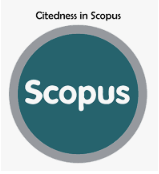PENINGKATAN KEMAMPUAN MENGENAL TUJUAN DAN FUNGSI TEKS TANGGAPAN DENGAN MODEL PEMBELAJARAN LEARNING COMMUNITY SISWA KELAS 9 G MTsN 1 TUBAN
DOI:
https://doi.org/10.56404/jels.v2i2.30Keywords:
student ability, response text, learning community modelAbstract
In the 2013 curriculum, the implementation of Indonesian language learning is done on a text-based. One of the texts taught in response text. Indicators of the success of learning response texts include students being able to recognize the purpose and function of response texts. It was found that many students had difficulty in learning. This is caused by the selection of an inappropriate learning model. Therefore, research was conducted to increase the ability to recognize the purpose and function of the response text by using the learning community learning model. The research method used is classroom action research. The subjects of this study were students of class 9G MTsN 1 Tuban. The process of implementing classroom action is through four stages starting from (1) planning, (2) action, (3) observing, and (4) reflecting. The types of instruments used are student observation sheets and teacher observation sheets, group evaluation sheets, test questions, and questionnaires. To test the validity of the data, the researcher used method triangulation and source triangulation techniques. The results of this study indicate that the learning of simple response texts has increased by using the learning community learning model. This can be seen from the average score of students before being given the action was 55.5, after being given the action at the end of the first cycle the average score became 61.80. Furthermore, at the end of the second cycle, the average score obtained was 71.80. While in the third cycle obtained an average score of 80.08. Overall, at the end of the third cycle, all aspects and criteria for recognizing the purpose and function of simple response texts experienced a significant increase
References
Anonim. 2002. Kurikulum dan Hasil Belajar Kompetensi Dasar Mata Pelajaran. Pusat Kurikulum, Balibang, Depdiknas.
Arikunta, Suharsimi. 2007. Penelitian Tindakan Kelas, Jakarta: Bumi Aksara.
Asrom, dkk. 1997. Belajar Mengarang Dari Narasi hingga Argumentasi. Jakarta: Erlangga.
Atmazaki. 2013. “Implementasi Kurikulum 2013 Mata Pelajaran Bahasa Indonesia: Pola Pikir, Pendekatan Ilmiah, Teks (Genre), dan Penilaian Otentik.” (Jurnal). Padang: Universitas Negeri Padang. http://ejournal.unp.ac.id/index.php/isla/article/download/3962/3193.
Departemen Pendidikan dan Kebudayaan. 1993. Petunjuk Pengajaran Membaca dan Manulis. Jakarta :P2M.
Departemen Pendidikan Nasioanal. 2003. Standar Kompetesi Mata Pelajaran Bahasa Indonesia. Jakarta: Depdiknas.
Gunawan, dkk. 1997. Belajar Mengarang. Jakarta: Erlangga.
Kemendikbud. 2014. Buku Guru Bahasa Indonesia. Jakarta: Kemendikbud.
Kemendikbud. 2014.Buku Siswa Bahasa Indonesia. Jakarta: Kemendikbud.
Kosasih, E. 2013. Jenis-Jenis Teks. Bandung : CV. Yrama Widya.
Majid, Abdul. 2006. Perencanaan Pembelajaran. Bandung: PT Remaja Rosdakarya.
Marwoto, M. 1987. Komposisi Praktis. Yogyakarta : Hanindita.
Muttaqin, Raisul 2004. Active Learning: 101 Cara Belajar Siswa Aktif Melvin L.Silberman. Bandung: Nusamedia.
Nurgiantoro, Burhan. 1987. Penelitian dalam Pengajaran Bahasa dan Sastra. Jogjakarta: BPFE.
Nurhadi. 1987. Dasar-dasar Evaluasi Pendidikan. Jakarta: Bumi Aksara.
Sari, Susi Metika & Setyo Budi Utomo. 2020. Meningkatkan Kemampuna Menelaah Kata Rujukan pada Teks Tanggapan Menggunakan Model Pembelajaran Discovery Learning pada Peserta Didik Kelas IX-C SMPN 4 Bandung Tahun Pelajaran 2019/2020. Jurnal Garda Guru, Vol. 02 No. 01, hlm. 38—49.
Sukardi. 2008. Meteodologi Penelitian Pendidikan. Jakarta : PT Bumi Aksara
Tarigan, Henry Guntur. 1982. Menulis. Bandung: Angkasa.
Waluyo, Herman J. 1994. Penelitian Pendidikan dan Sastra. Surakarta: Sebelas Maret University Press.
Wiriaatmaja, Rochiati. 2006. Metode Penelitian Tindakan Kelas. Bandung: PT Remaja Rosdakarya.
















